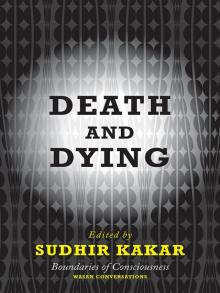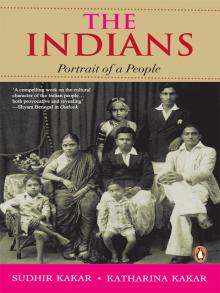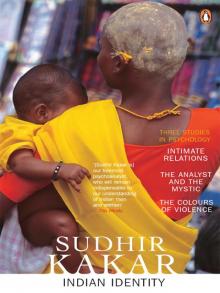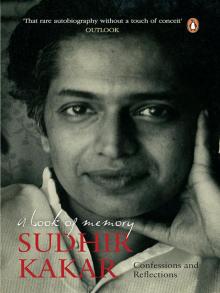- Home
- Sudhir Kakar
Death and Dying Page 3
Death and Dying Read online
Page 3
In many other cases the communication is a warning:
I was driving home from work and was in a big hurry … I was about to change lanes when I heard, as plainly as day, my father’s voice come from the back seat, yelling, ‘Butchie, look out.’ No other person ever called me Butchie, and my father had been dead for three years. When I immediately stayed in my lane, a pickup truck came around on the wrong side. Had I changed lanes, I am certain I would have had a very serious accident.
The next case is not only another example of a warning case, but, perhaps more importantly, an example of a collective case, that is, one in which more than one person has seen, heard, or otherwise experienced the apparition, such as the case above of the husband and wife smelling his mother’s cologne. Collective cases do not occur frequently, but partly this is because most apparitional experiences occur when the person is alone. In situations when another person is present, about a third (H. Sidgwick et al., 1894, pp. 320–321; Tyrrell, 1943/1953, p. 23) to half (H. Hart et al., 1956, pp. 204–05) involve collective perception. This next case was investigated and reported by members of the SPR in the late 19th century (Myers, 1889, pp. 26-29). Mr and Mrs P had just gone to bed:
It was still just about 9.30 … and I [was] just pulling myself into a half-sitting position against the pillows … when to my great astonishment I saw a gentleman standing at the foot of the bed … I was too astonished to be afraid … instantly touching my husband’s shoulder (whose face was turned from me), I said, ‘Willie, who is this?’ My husband turned, and for a second or two lay looking in intense astonishment at the intruder; then lifting himself a little, he shouted, ‘What on earth are you doing here, sir?’ Meanwhile, the form, slowly drawing himself into an upright position, now said in a commanding, yet reproachful voice, ‘Willie! Willie!’
The man was Mr P’s father, who had died fourteen years earlier and whom Mrs P had never met. It turned out that Mr P had begun to embark on what would have been a disastrous financial course had he persisted, which he did not do after this apparent warning from his father.
Collective cases are particularly important because they suggest that something objective, and not a subjective or telepathic hallucination, has stimulated the perception by more than one person, often with appropriate differences of perspective (see, e.g., Myers, 1886). Another particularly interesting feature of Mr and Mrs P’s case is that, as the apparitional figure moved and passed by a lamp in the room, ‘a deep shadow fell upon the room as of a material person shutting out the light from us by his intervening body’. Other cases are reported in which the apparitional figure is seen reflected in a mirror. Such apparitions provide further evidence that they are not physical in the ordinary sense, but nonetheless objective, or ‘quasi-physical’ enough to stimulate a sensory perception and to block light or reflect in a mirror.
Warning cases such as the two above also suggest that the deceased can have continuing knowledge or awareness of events among the living—that is, that there is some sort of interpenetration or interaction between the ordinary physical and post-mortem worlds. And the quasi-physical nature of many experiences, such as smells, moving glasses, blocked lights, reflections in mirrors, and the appearance to more than one person, similarly suggest some kind of continuity between a pre-mortem and post-mortem world. The more we learn about the universe, the more we have come to see that the boundaries we put up between various phenomena are often not so clear-cut as we may have assumed. Many of the familiar dualisms are not so obvious any more. As our observations in biology have become more microscopic, the line between living and non-living things is not always clear. And with the rise of modern physics, the line between matter and energy has disappeared, and matter itself seems more and more mind-like in nature. Given this blurring of boundaries, it seems likely that, if there is a post-mortem existence, it is in some sense continuous with the natural world we know, and not some wholly discrete supernatural one.
Near-Death Experiences and Deathbed Visions
NDEs in particular have become highly visible in the past thirty-five years, not only in popular media, but in medical literature as well. Many people who recover, for example, from cardiac arrest, a difficult childbirth, or a sudden accident or near-drowning have reported experiencing something extraordinary while they were physically unconscious. They often report being out of their bodies and watching what is going on, whether in the emergency room or at the scene of the accident. Some report going through a dark tunnel and seeing a bright light. Some report meeting deceased loved ones. Some report a sudden revival of long-lost memories, or even a complete and extremely rapid life-review. Many people report a complete cessation of pain, and instead a feeling of joy or peace. They also report that their minds and senses were more alert and clear than usual, and many say that, far from being like a dream, this was the most intense and vivid experience of their lives. Again, let us give some examples. One person (among the thousand or so cases in the collection at DOPS alone) was a utility lineman who was electrocuted on the job. He said:
I could see myself laying [sic] on the ground, very plainly. It was a feeling as though I was floating in a tunnel with a couple of white doves flying along. The further down the tunnel I went, it became lighter, and when I got closer to the end I could see a human figure, which was my [deceased] mother, motioning for me to go back—not to come any further. After she motioned me back, I came to, with the paramedics working over me (Kelly, 2001, p. 232).
Another person who contacted us was a man who was having an emergency coronary bypass operation (Cook, Greyson, & Stevenson, 1998, pp. 399–401). While he was under anaesthesia, he had the following experience:
I began my journey in an upward direction and found myself in a very thick, black, billowy smoke-like atmosphere … [Then I saw] of all things, me. I was laying [sic] on a table covered with light-blue sheets, and I was cut open so as to expose my chest cavity … I was able to see my surgeon … He appeared to be somewhat perplexed. I thought he was flapping his arms as if trying to fly.
This man reported many other things as well, including seeing his deceased mother and brother-in-law, a brilliant yellow light coming from a tunnel, and a feeling of what he described as ‘euphoria’. From an objective perspective, the unusual sight of the surgeon flapping his arms was of particular interest, and we were able to confirm from the doctor that before beginning a surgery, he has the unusual habit of tucking his scrubbed hands under his arms, so as not to contaminate them, and then giving instructions to the staff by pointing with his elbows.
Many people who have these experiences are convinced by them that they will survive death. Even for someone who has not had such an experience, the reports of others are often compelling subjective evidence for survival. Objective features of the cases, such as seeing in the operating room an unusual, unexpected, actual event, are particularly impressive. But NDEs provide an even more compelling reason for taking seriously, from a scientific viewpoint, the idea that consciousness may survive the death of the brain. Mainstream neuroscientists are united in the view that our mental life exists only in conjunction with oscillatory neuroelectric activity that can link widely separated parts of the brain to produce a unified conscious experience. And yet many—literally thousands—of NDEs occur in connection with cardiac arrest or deep general anaesthesia (or both), when the conditions neuroscientists say are necessary for consciousness have been abolished. Not only that, but these are not vague, confused, fuzzy sensations but, as one six-year-old cardiac-arrest victim put it, ‘realer than real’. Moreover, they are certainly not, as some neuroscientists have recently claimed, the result of a patient’s waking up during general anaesthesia. Premature awakenings from anaesthesia typically involve extreme fear, pain, paralysis and panic. In stark contrast, an NDE is usually described as pleasant or even, as in the case described in the previous paragraph, ‘euphoric’—extremely joyful and peaceful, and pain-free. Mind is apparently not so d
ependent on brain as many have come to assume.
One particularly striking example of an NDE occurring under conditions that would, if current neuroscientific views were correct, preclude any conscious experience at all is the Pam Reynolds case (Sabom, 1998, pp. 37–51). Pam underwent a procedure called hypothermic cardiac arrest for the removal of a large aneurysm deep in her brain that would be fatal if it ruptured and that was inaccessible by ordinary neurosurgical techniques. Following induction of deep general anaesthesia, her skull was opened, and she was connected to a cardiopulmonary bypass machine. Her circulating blood was chilled, her heart was deliberately stopped, and her electroencephalogram (EEG) went flat. She had reached ‘total brain shutdown’. At this point, the blood was drained from her brain so that the aneurysm could be safely removed. Her blood was then warmed and returned to her body, and her vital functions gradually restored. During the resuscitation procedures, however, her heart went into ventricular fibrillation, and she had to be shocked twice to restore normal rhythm.
Not only the drastic surgical procedure itself, but the cardiac arrest during the resuscitation process shut down all functioning that neuroscientists say is essential for consciousness. Nevertheless, during this time Pam had a continuous and remarkable experience. First, despite moulded speakers in her ears delivering 95-decibel clicks (for monitoring her brainstem function), she heard the sound of the special saw used to cut into her skull. She then seemed to leave her body and, from a position near the neurosurgeon’s shoulders, was able to see (and subsequently describe) the saw itself, despite her eyes being taped shut. She also noted the unexpected (to her) way in which her head had been shaved, and she heard a female voice commenting that her veins and arteries were small. At some point she felt herself being pulled along a ‘tunnel vortex’ towards a light. She also heard her deceased grandmother’s voice and saw numerous deceased relatives, all of them permeated by an ‘incredibly bright’ light. Told by her relatives that she had to go back, and thinking about the young children she would be leaving, she reluctantly returned to her body.
Although many of the features of her experience were subjective and unverifiable, some were not. Her description of the unusual saw was verified by the neurosurgeon and by photographs of it obtained by Dr Sabom. Also, at the time the cardiopulmonary bypass procedure was being started, the cardiac surgeon (a female) had commented that the right femoral vessels were too small to support the bypass so that she had to prepare the left leg.
Equally importantly, Pam reported being vividly conscious: She said that during her experience she was not only aware, but ‘the most aware that I think I have ever been in my life’. She further commented that her vision ‘was not like normal vision. It was brighter and more focused and clearer than normal vision’, and that her hearing ‘was a clearer hearing than with my ears’.
As we mentioned earlier, another type of experience is sometimes reported in connection with dying patients who do not recover. Since we rarely learn about these from the patients themselves, but only from people who were with them, our knowledge of what the patients are actually experiencing is limited. But what onlookers report is that dying people often seem to be seeing or talking with someone who is not physically in the room, usually a deceased spouse, friend or sibling. Systematic research on these experiences is just beginning, even though hospice workers tell us that they are extremely common, and in Emily’s survey the single-most common experience reported was being at the deathbed of someone who seemed to be seeing deceased loved ones. Here is an example from that survey:
Right before my grandma died she looked up with a beautiful smile and said ‘Hi, Edward [this was my grandpa]. I have missed you so much.’ Then she died.
Although the initial reaction of most people when they hear such a story is that drugs night have produced the experience, preliminary research suggests that such experiences actually occur less often when the patient is taking pain medication, is sedated, or is taking other drugs. And the interpretation of these experiences is further complicated when we realize that sometimes, not the dying person, but a bystander at the bedside sees something unusual. In the following case (Stevenson, 1995, pp. 361–63), the dying person had suffered a stroke and was in a coma, when her son-in-law (a physician) had this experience:
I was standing by her bed and no one else was in the room. She had an agonal inspiration, and at that moment I had a very clear picture [of her deceased husband] standing across from me with his arms outstretched, and he said: ‘[Her nickname], I’ve been waiting for you.’
People frequently suggest that deathbed visions are produced by expectation or wishful thinking. But there are many experiences in which a dying person sees someone they did not know was dead (for a list of references to such cases, see Kelly et al., 2007, p. 410). Ian Stevenson (1959, p. 22) learned about the following case in the 1950s, when communication was not quite so instantaneous as it is today:
An elderly woman … became seriously ill. When the doctors said that she did not have long to live, the family gathered around her bed. Suddenly she seemed much more alert and the expression on her face changed to one of great pleasure and excitement. She raised herself slightly and said: ‘Oh, Will, are you there?’—and fell back dead.
No one present was named Will, and no one present knew who Will might be, but shortly afterwards they learned that the woman’s brother, Will, who lived in England, had died two days before her own death.
Another type of experience is not a deathbed vision, but nonetheless an especially important type of deathbed experience. We call these terminal lucidity, or revival, cases, because they often involve people who are comatose or suffering from dementia, and who seem to regain their faculties shortly before death (Nahm & Greyson, 2009; Nahm, Greyson, Kelly, & Haraldsson, in press). Cases like this have been mentioned in medical literature for centuries. For example, the great 18th-century physician Benjamin Rush referred to them briefly in his medical textbook, talking about them as if it were common knowledge that people suffering from dementia regain their faculties shortly before dying. Rush’s observation would probably come as a great surprise to most people in the medical profession today, because now we rarely hear about them, and so far there has been no research specifically in this area.
One example was reported recently by an orthopedic surgeon, Dr Scott Haig, in Time magazine (Haig, 2007). The entire issue was focused on the mind—body problem, and was written mainly by materialistic scientists jubilantly declaring that we will ultimately explain everything about mind and consciousness as the knowledge of the brain grows. But then there was this beautiful little essay, tacked on at the very end of the issue, almost as an afterthought. We summarize what happened:
A patient David was dying of lung cancer that had spread to his brain. A brain scan showed barely any brain left. In the days before his death he was completely unresponsive. When Dr Haig left one evening, David was clearly dying, but the following morning a nurse reported: ‘He woke up, you know, doctor—just after you left—and said goodbye to all of them … He talked to them and patted them and smiled for about five minutes. Then he went out again, and he passed in the hour.
Dr Haig’s comment: ‘It wasn’t David’s brain that woke him up to say goodbye that Friday. His brain had already been destroyed … What woke my patient that Friday was simply his mind, forcing its way through a broken brain, a father’s final act to comfort his family.’
A similar case, this one involving not brain cancer but dementia, was reported to DOPS recently:
My grandmother chatted with me the week before she died, after not talking or reacting for a number of years—it was like talking to Rip Van Winkle, as we chatted about what had been happening with family members while she was ‘gone’.
Like many NDEs under cardiac arrest or general anaesthesia, these terminal lucidity, or revival, cases suggest that, when the brain is shutting down, its hold on the mind loosens, and the mind i
s then freed to function again. As Dr Haig said about David, his mind broke free from its cancer-ridden brain and could function again.
Mediumship
The last two types of experiences that we want to discuss, mediumship and cases of the reincarnation type, are especially difficult to summarize because there is such an enormous body of cases and research related to them—this despite the fact that the research has been carried out by only a handful of people. Again, we will cite just a few examples to give a flavour of what we’re talking about.
We will begin with mediumship, because it was among the first and most important areas of research for the early psychical researchers (Gauld, 1982). Mediums are defined as people who seem to be able to communicate with the dead, usually when in a trance or other altered state of consciousness. We mentioned earlier that mediumship occurs in a small and highly unusual population. In fact, despite the large numbers of people who claim to be mediums, from the beginnings of Spiritualism in the mid-19th century up to today, the vast majority of the serious research has been centred on a half-dozen or so people who have proved particularly good at providing, under highly controlled conditions, accurate information about specific deceased people that they did not learn about in any normal way.
Let us begin by briefly mentioning one of the most famous and carefully studied mediums who ever lived, Leonora Piper. She was a Boston housewife, discovered by William James in 1885 when his mother-in-law had a sitting with her that she found quite remarkable. Over the next several decades James and his fellow psychical researchers in America and Britain had sittings with her and, more importantly, took large numbers of anonymous sitters to her and recorded the results. They even went so far as to have Mrs Piper followed by private investigators to be sure she was not cheating with the help of accomplices—a precaution that has not stopped modern-day scoffers from asserting this ‘explanation’ anyway. The evidential and psychological material on Mrs Piper is vast, and we will mention only one small part of it. In 1892, George Pellew (GP), a young acquaintance of Mrs Piper’s primary investigator, Richard Hodgson, died suddenly. Shortly afterwards he began appearing in Mrs Piper’s seances as a communicator. The investigators then began a long series of sittings in which they brought 150 anonymous sitters to Mrs Piper while she was in her trance state. Of these 150, thirty were people known to GP in his lifetime, and 120 were strangers. GP recognized all those, and only those, he had known, and provided them with numerous and appropriate details of events and memories they shared.

 Death and Dying
Death and Dying The Indians
The Indians The Crimson Throne
The Crimson Throne Indian Identity
Indian Identity A Book of Memory
A Book of Memory